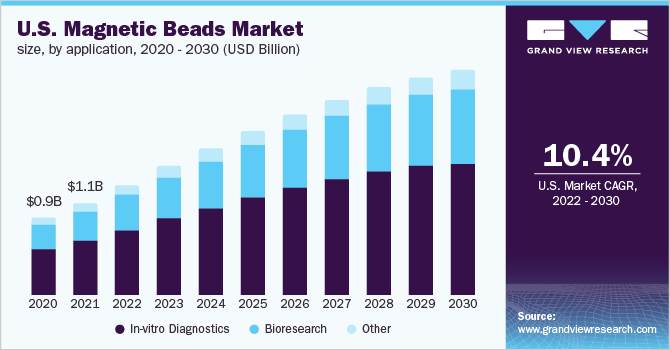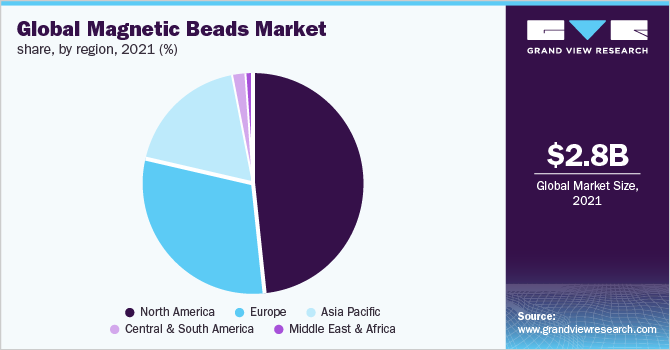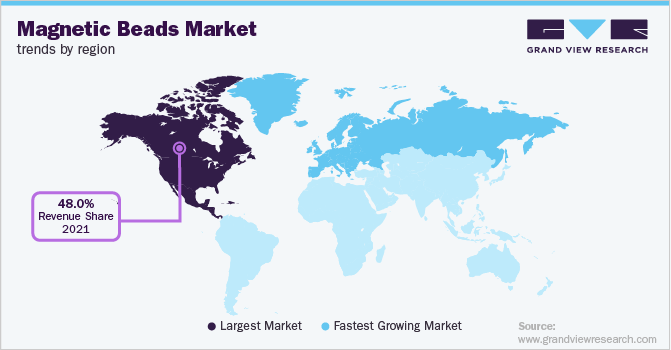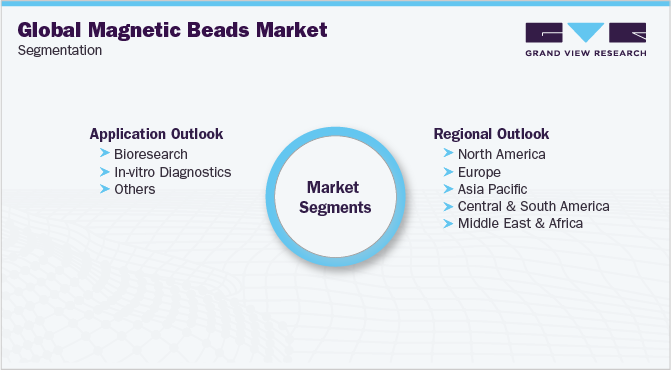- Home
- »
- Advanced Interior Materials
- »
-
Magnetic Beads Market Size & Share, Global Report, 2030GVR Report cover
![Magnetic Beads Market Size, Share & Trends Report]()
Magnetic Beads Market Size, Share & Trends Analysis Report By Application (Bioresearch, In-vitro Diagnostics, Others), By Region (North America, Europe, Asia Pacific, CSA, MEA), And Segment Forecasts, 2022 - 2030
- Report ID: GVR-4-68039-261-1
- Number of Report Pages: 94
- Format: PDF, Horizon Databook
- Historical Range: 2017 - 2020
- Forecast Period: 2022 - 2030
- Industry: Advanced Materials
Report Overview
The magnetic beads market size was estimated at USD 2.79 billion in 2021 and is expected to expand at a compound annual growth rate (CAGR) of 11.6% from 2022 to 2030. The market is witnessing rapid growth in molecular biology applications owing to their easy-to-use property, minimal processing requirement, and reliability. It is further used to purify various biomolecules such as genomic plasmids, DNA, RNA, proteins, and mitochondrial DNA, which is expected to drive the market.

The global outbreak of COVID-19 has fueled the demand for antibody test laboratories, clinical research labs, vaccine development labs, and the establishment of in-vitro diagnostics facilities. Chronic disease blood sample testing and treatment have seen a surge as individuals suffering from any chronic disease such as kidney problems or cancer are more prone to the virus. This is further expected to increase the use of magnetic beads, hence, positively contributing to the market growth.
The market for magnetic beads is expected to witness notable growth on account of the increasing demand for healthcare products. For instance, ease of operations, rapid result, and direct-to-consumer testing further facilitate the adoption of in-vitro diagnostics. Moreover, the increasing trend of point-of-care (POC) outside the laboratory or at the doorstep, coupled with the increasing population and high-scale spreading of chronic diseases, is expected to promote the usage of magnetic beads.
Favorable government standards and policies in the U.S. are also anticipated to boost magnetic beads market growth in the coming years. For instance, in vitro devices have been defined in section 201(h) of the Federal Food, Drug, and Cosmetic Act and as biological products subject to section 351 of the Public Health Service Act. Additionally, healthcare spending in the U.S. is likely to witness an increase because of advancements in medical technologies, rising medical equipment prices, and increased demand for medical services from the aging population.
Nanomaterials such as magnetic beads possess physicochemical properties that vary from general bulk materials, which make them an ideal material to be used in multiple applications in nanomedicine. Technological advancements in the medical industry have led to the emergence of nanomagnetic and radio-frequency induction treatments, which, in turn, are anticipated to drive the demand in medical applications. Hence, the rising adoption of nanomaterials in curing tumors is also projected to augment market growth.
The market for magnetic beads exhibits a huge potential for growth on account of continuous research & development activities over recent years. The growing popularity of magnetic beads coupled with diversified applications in several industries such as genetic research, diagnostics, and pharmaceuticals superparamagnetic properties is expected to drive the market.
Application Insights
The in-vitro diagnostic application segment led the market and accounted for more than 58.9% of the global revenue share in 2021. This is due to the increasing use of bio-separation techniques for the targeted cell or molecule type, which has applications for magnetic beads. Additionally, the growing demand for cellular study by various scientists and pharma companies to determine physiological and chemical mechanisms within a molecule is expected to contribute further to market growth.
There has been an increase in investments and spending in the life sciences and pharmaceutical industry research, which is correlated to market development. The growing occurrence of infectious diseases, including HIV and Zika virus, has triggered the demand for blood sampling tests which contributes to the growth of magnetic beads.
Magnetic beads offer a suitable solution that could revolutionize a wide range of biological research by enhancing the efficacy of cell separation and isolation protocols. Furthermore, the product uses optimizing necessary laboratory techniques, such as isolation of bio-molecules, enzyme-linked immunosorbent assay (ELISA), and polymerase chain reaction (PCR) for making copies of DNA samples is further expected to evolve in the field of biological research rapidly. Hence, such technologies are likely to witness promising growth in the market for magnetic beads during the forecast period.
The magnetic separation method is the only feasible solution for the recovery of minute and small particles (diameter ranging from 0.05 to 1μm) in the presence of biological debris of similar size from different fluidic samples under clinical research and experiments. In addition, the growing access to different fields of experimental biology, including cell biology, biotechnology, biochemistry, and genetics is expected to be opportunistic for the market during the forecast period.
Regional Insights
North America dominated the market and accounted for over 48.0% share of global revenue in 2021. Continuous efforts in the research and development of nanotechnology to explore potential applications in various end-use industries have boosted regional growth. Furthermore, growing emphasis on the use of magnetic beads in drug delivery and other biomedical is expected to have a positive impact on market growth during the forecast period.

The U.S. and Canada have an escalating growth in the bioresearch industry; this is further expected to drive the demand in the coming years. Various strategical collaborations and partnerships are being witnessed in Canada, marking the growth of bioresearch in the country. The healthcare industry is further expected to grow due to favorable government policies and escalate the market for magnetic beads further in the forecast period.
Europe accounts for the second largest market share in magnetic beads due to the increased demand for therapeutic and diagnostics solutions for the rising health concerns. Also, the rising rate of infectious diseases, mental health issues, and COVID-19 have increased the demand for healthcare facilities and related diagnostics centers to tackle and minimize the situation throughout the region.

The Asia Pacific region is expected to expand at a significant rate owing to the rapid growth of healthcare and diagnostics industries in China and Japan. Due to attractive government policies and regulations coupled with increasing expenditure in the medical industry. The growing need for the adoption of advanced diagnostic technologies due to the increasing prevalence of chronic diseases is expected to drive the magnetic beads to demand in the region.
Key Companies & Market Share Insights
The market for magnetic beads is characterized by the presence of limited vendors, resulting in a low level of concentration of vendors. The increasing demand for medical beads on account of their increasing use in the medical industry is fueling the growth. The key magnetic beads manufacturers are focused on increasing the penetration of medical beads in different medical product offerings.
A large number of magnetic beads manufacturers are focused on research activities to increase the applications of the product in diverse segments. In addition, there are various emerging technologies in the field of nanotechnology, which are expected to drive the demand in the coming years. For instance, magnetic beads are now used in bone repair and regeneration applications in the healthcare industry. Some of the prominent players in the global magnetic beads market include:
-
Thermo Fisher Scientific Inc.
-
Merck KGaA
-
Bangs Laboratories Inc.
-
Spherotech, Inc
-
GenScript
-
CardioGenics Inc.
-
Bio-Rad Laboratories, Inc
-
Miltenyi Biotec
-
Ferrotec (USA) Corporation
-
Eurofins Technologies
-
Micromod Partikeltechnologie GmbH
-
New England Biolabs
-
Rockland Immunochemicals, Inc.
-
MagQu Co. Ltd
Magnetic Beads Market Report Scope
Report Attribute
Details
Market size value in 2022
USD 3.37 billion
Revenue forecast in 2030
USD 7.50 billion
Growth Rate
CAGR of 11.6% from 2022 to 2030
Base year for estimation
2021
Historical data
2017 - 2020
Forecast period
2022 - 2030
Quantitative units
Volume in Kilograms, revenue in USD Million, and CAGR from 2022 to 2030
Report coverage
Volume forecast, revenue forecast, company ranking, competitive landscape, growth factors, and trends
Segments covered
Application, Region
North America; Europe; Asia Pacific; Central & South America; Middle East & Africa
Country scope
U.S.; Canada; Mexico; U.K.; Germany; France; China; Japan; India; Brazil
Key companies profiled
Thermo Fisher Scientific Inc.; Merck KGaA, Bangs Laboratories Inc.; Spherotech, Inc; GenScript; CardioGenics Inc.; Bio-Rad Laboratories, Inc.; Miltenyi Biotec; Ferrotec (USA) Corporation; Eurofins Technologies; Micromod Partikeltechnologie GmbH; New England Biolabs; Rockland Immunochemicals, Inc.; MagQu Co. Ltd
Customization scope
Free report customization (equivalent up to 8 analysts working days) with purchase. Addition or alteration to country, regional & segment scope.
Pricing and purchase options
Avail customized purchase options to meet your exact research needs. Explore purchase options
Global Magnetic Beads Market Segmentation
This report forecasts revenue growth at global, regional & country levels and provides an analysis of the industry trends in each of the sub-segments from 2017 to 2030. For this study, Grand View Research has segmented the global magnetic beads market based on application and region:

-
Application Outlook (Volume, Kilograms, Revenue, USD Million, 2017 - 2030)
-
Bioresearch
-
In-vitro Diagnostics
-
Others
-
-
Regional Outlook (Volume, Kilograms, Revenue, USD Million, 2017 - 2030)
-
North America
-
U.S.
-
Canada
-
Mexico
-
-
Europe
-
Germany
-
U.K.
-
France
-
-
Asia Pacific
-
China
-
India
-
Japan
-
-
Central & South America
-
Brazil
-
-
Middle East & Africa
-
Frequently Asked Questions About This Report
b. The global magnetic beads market size was estimated at USD 2.79 billion in 2021 and is expected to reach USD 3.37 billion in 2022.
b. The magnetic beads market is expected to grow at a compound annual growth rate of 11.6% from 2022 to 2030 to reach USD 7.50 billion by 2030.
b. In-Vitro diagnostics applications dominated the magnetic beads market with a share of over 58% in 2021. This is attributed to the rise in demand from the healthcare sector owing to their greater accuracy levels.
b. Some of the key players operating in the magnetic beads market include Thermo Fisher Scientific Inc., Merck KGaA, Bangs Laboratories Inc., Spherotech, Inc, GenScript, CardioGenics Inc., Bio-Rad Laboratories, Inc, Miltenyi Biotec, Ferrotec (USA) Corporation, Eurofins Technologies, Micromod Partikeltechnologie GmbH, New England Biolabs, Rockland Immunochemicals, Inc., and MagQu Co. Ltd.
b. The key factors driving the magnetic beads market include an increase in the use of bio-separation techniques for the targeted cell, or molecule type has the most widespread use of magnetic beads in the market.
Share this report with your colleague or friend.
![gvr icn]()
NEED A CUSTOM REPORT?
We can customize every report - free of charge - including purchasing stand-alone sections or country-level reports, as well as offer affordable discounts for start-ups & universities. Contact us now
![Certified Icon]()
We are GDPR and CCPA compliant! Your transaction & personal information is safe and secure. For more details, please read our privacy policy.
We are committed towards customer satisfaction, and quality service.
"The quality of research they have done for us has been excellent."





